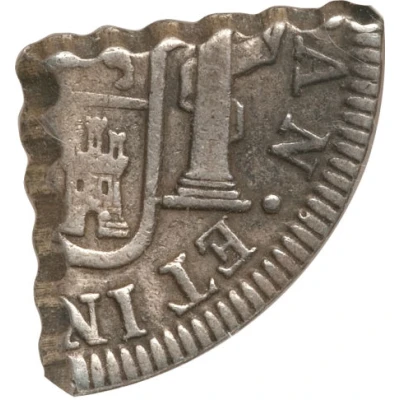


© Heritage Auctions
66 Shillings (Countermark on contemporary counterfeit Brazil Joao I gold 6400 Reis 1773-R) ND
| Gold | 11.588 g | - |
| Issuer | Martinique (Overseas France) |
|---|---|
| Type | Standard circulation coin |
| Value | 66 Shillings |
| Currency | British occupation |
| Composition | Gold |
| Weight | 11.588 g |
| Shape | Round |
| Technique | Countermarked |
| Demonetized | Yes |
| Updated | 2024-10-04 |
| Numista | N#126591 |
|---|---|
| Rarity index | 97% |
Reverse
Arms
Comment
Extremely Rare, Possible Quadruple Island IssueBritish Colonial gold regulated 66 shillings ND (later than 1805) Weight 11.588 grams. Base coin (contemporary counterfeit Brazil Joao I gold 6400 Reis 1773-R) Extremely Fine with sharp details, countermarks nearly Uncirculated with some "249" in thin numbers engraved to the right of the bust on the obverse accounting for the designation. A fascinating double or quadruple regulated gold coin, with the alternative sequences being as follows:
- Regulated in Martinique in 1805 (Arrete of 26 September 1805) with the 20 over eagle counterstamp (Gordon variety B) to pass by weight (which was lower than 11.66 grams since unplugged at the time).
- Regulated in Grenada later than 1805 at the 11.66 weight standard to pass as 66 Shillings, with a central plug and the "G. S" punch.
If one accepts this sequence, then it must be concluded that the Gordon variety "I" "G" stamps were applied much later than 1798. The alternative longer sequence would instead be:
- Regulated in Grenada in 1798 (Proclamation of 31 July 1798) at the 11.66 weight standard to pass as 66 Shillings, presumably with a low-gold plug. The three "G" stamps applied near the edge are Gordon variety "I".
- Regulated in Guadeloupe in 1803 (Arrete of 22 April 1803) by removing the plug applied in Grenada in 1798 to pass by weight.
- Regulated in Martinique in 1805 (Arrete of 26 september 1805) with the 20 over eagle counterstamp (Gordon variety B) to pass by weight.
- Brought back to the 11.66 gram standard by goldsmith "G.S" (identity unknown to the cataloguer) whose initials were stamped over the new center plug.
If one accepts the longer sequence, one also must accept that the coin was indeed plugged when regulated in Grenada in 1798 (with a different plug from the current one) since it's unplugged weight would have been below the minimal accepted weight of 11.66 grams. Since the coin was plugged in 1798 (and that plug is not the current one, since the latter is struck over the Martinique stamp made in 1805), the original plug must have been removed between 1798 and 1805, an operation which was performed and legally authorized in Guadeloupe in 1803, as noted.
This quite interesting partial numismatic enigma might be solved by identifying goldsmith "G. S"!
Interesting fact
One interesting fact about this coin is that it is a countermarked coin, meaning that it was issued by a colonial power (in this case, France) and bears a countermark, or a stamp, that indicates its authenticity and value. The countermark on this coin is particularly interesting because it is a counterfeit mark, indicating that the coin was originally a fake, but was later authenticated and stamped by the colonial power to confirm its value. This highlights the complex history of currency and trade in the colonial era, and the ways in which coins were used to facilitate economic exchange and establish power dynamics between colonizer and colonized.



